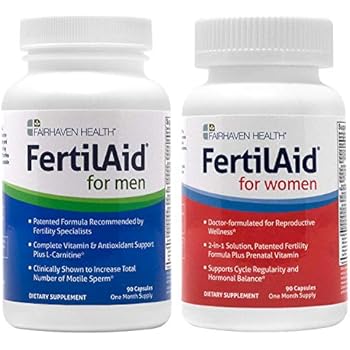Fertility is a complex interplay of numerous biological, environmental, and psychological factors, particularly for women. As more couples seek to conceive, the demand for supplements that support female fertility has surged. One such product is FertilAid, a fertility supplement designed to promote reproductive health in women. In this article, we delve into the science behind the key ingredients in FertilAid and how they contribute to improved fertility.
Understanding Fertility: The Basics

Before we explore the ingredients of FertilAid, it’s crucial to understand the factors influencing female fertility. Female fertility is largely governed by hormonal balance, egg quality, ovulation, and overall reproductive health. Various lifestyle factors—such as diet, exercise, and stress levels—also play significant roles. With this foundation, we can better appreciate how specific ingredients in FertilAid target these areas.
Key Ingredients in FertilAid

FertilAid contains a blend of vitamins, minerals, and herbal ingredients, each selected for their potential to enhance fertility. Below are the key ingredients and the science behind them.
- Folic Acid
- Vitamin E
- Vitex (Chaste Tree Berry)
- Coenzyme Q10
Folic Acid: The Essential B Vitamin
Folic acid, also known as Vitamin B9, is critical for DNA synthesis and repair. It is particularly important during the early stages of pregnancy.
- Reduces Neural Tube Defects: Research indicates that adequate folic acid intake before conception can significantly reduce the risk of neural tube defects in the developing fetus.
- Supports Ovarian Function: Folic acid is essential for proper ovarian function, influencing the quality and quantity of eggs produced.
A study published in the journal “Human Reproduction” found that women with higher folate levels had better fertility outcomes, reinforcing the importance of this vitamin in preconception health.
Vitamin E: The Antioxidant Powerhouse

Vitamin E is a potent antioxidant that protects cells from oxidative stress, which can negatively impact fertility.
- Improves Egg Quality: Antioxidants like Vitamin E can enhance egg quality by reducing oxidative damage.
- Supports Hormonal Balance: Vitamin E is known to support hormonal balance, which is crucial for regular ovulation.
A review in the “Journal of Reproductive Medicine” highlighted that women with higher Vitamin E levels tended to have improved fertility rates, making it a valuable addition to any fertility-supporting supplement.
Vitex (Chaste Tree Berry): Nature’s Hormone Regulator

Vitex, or Chaste Tree Berry, is a herbal remedy traditionally used to regulate menstrual cycles and alleviate premenstrual symptoms.
- Balances Hormones: Vitex works by influencing the pituitary gland to regulate the production of luteinizing hormone (LH) and follicle-stimulating hormone (FSH), essential for ovulation.
- Enhances Luteal Phase: Many women experience luteal phase defects, which can hinder implantation. Vitex has been shown to lengthen and enhance the luteal phase, promoting a more favorable environment for pregnancy.
A clinical trial published in “Phytomedicine” found that Vitex supplementation significantly improved menstrual cycle regularity and ovulation in women with irregular cycles.
Coenzyme Q10: Fuel for Energy Production

Coenzyme Q10 (CoQ10) is a naturally occurring antioxidant found in the body, essential for energy production in cells.
- Supports Oocyte Quality: CoQ10 is critical for mitochondrial function, which is essential for the energy demands of oocytes (eggs). Higher levels of CoQ10 have been linked to improved egg quality.
- Decreases Age-Related Fertility Decline: Research suggests that CoQ10 may help counteract the natural decline in fertility that occurs with age, making it particularly beneficial for women over 35.
A study in “Fertility and Sterility” indicated that women undergoing IVF with CoQ10 supplementation showed significantly higher fertilization rates compared to those not taking the supplement, emphasizing its role in enhancing fertility potential.
Case Studies and Statistics

Numerous studies and anecdotal evidence support the efficacy of these ingredients in enhancing female fertility.
- Case Study on Folic Acid: A study published in “Obstetrics & Gynecology” showed that women who took folic acid supplements before conception had a 50% lower risk of infertility.
- Vitex and Hormonal Balance: A randomized controlled trial found that 80% of women taking Vitex experienced improved menstrual regularity and ovulation.
- CoQ10 in IVF: Research indicated that women who supplemented with CoQ10 during IVF had a 50% higher success rate in achieving pregnancy.
These statistics underscore the potential benefits of incorporating FertilAid into a fertility-enhancing regimen. However, it is essential to consult with a healthcare provider before starting any supplement, particularly for women with underlying health conditions or those undergoing fertility treatments.
Conclusion: The Path to Enhanced Fertility
Fertility is a multifaceted issue, and the ingredients in FertilAid—folic acid, Vitamin E, Vitex, and Coenzyme Q10—offer scientifically supported benefits that can enhance female reproductive health. By improving hormonal balance, egg quality, and overall reproductive function, these ingredients can play a crucial role in supporting women on their journey to conception.
As research continues to evolve, it is essential for women to stay informed about their reproductive health and consider natural supplements like FertilAid as part of a holistic approach to fertility. Always consult with a healthcare professional to tailor a plan that suits individual needs and circumstances.
In summary, understanding the science behind these ingredients can empower women to make informed choices regarding their fertility health, ultimately paving the way towards successful conception and a healthy pregnancy.